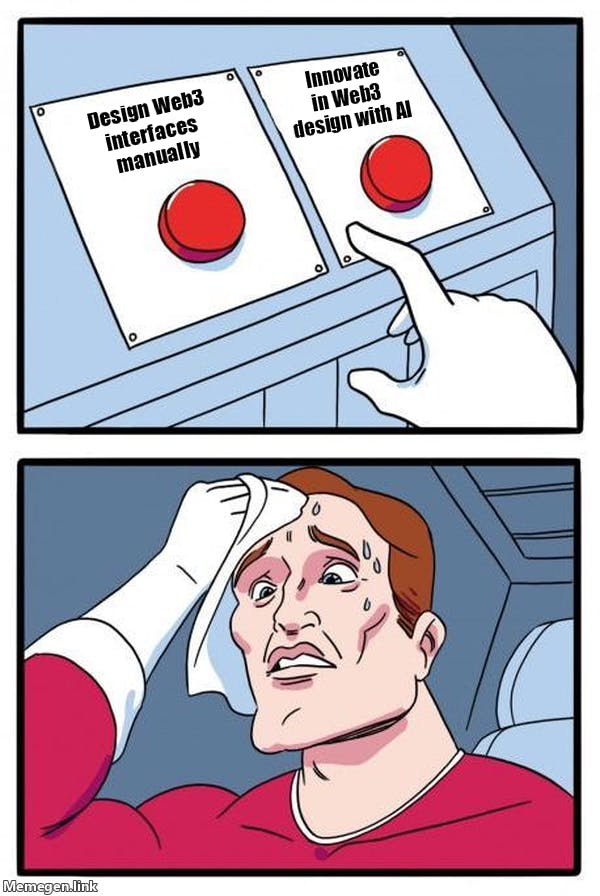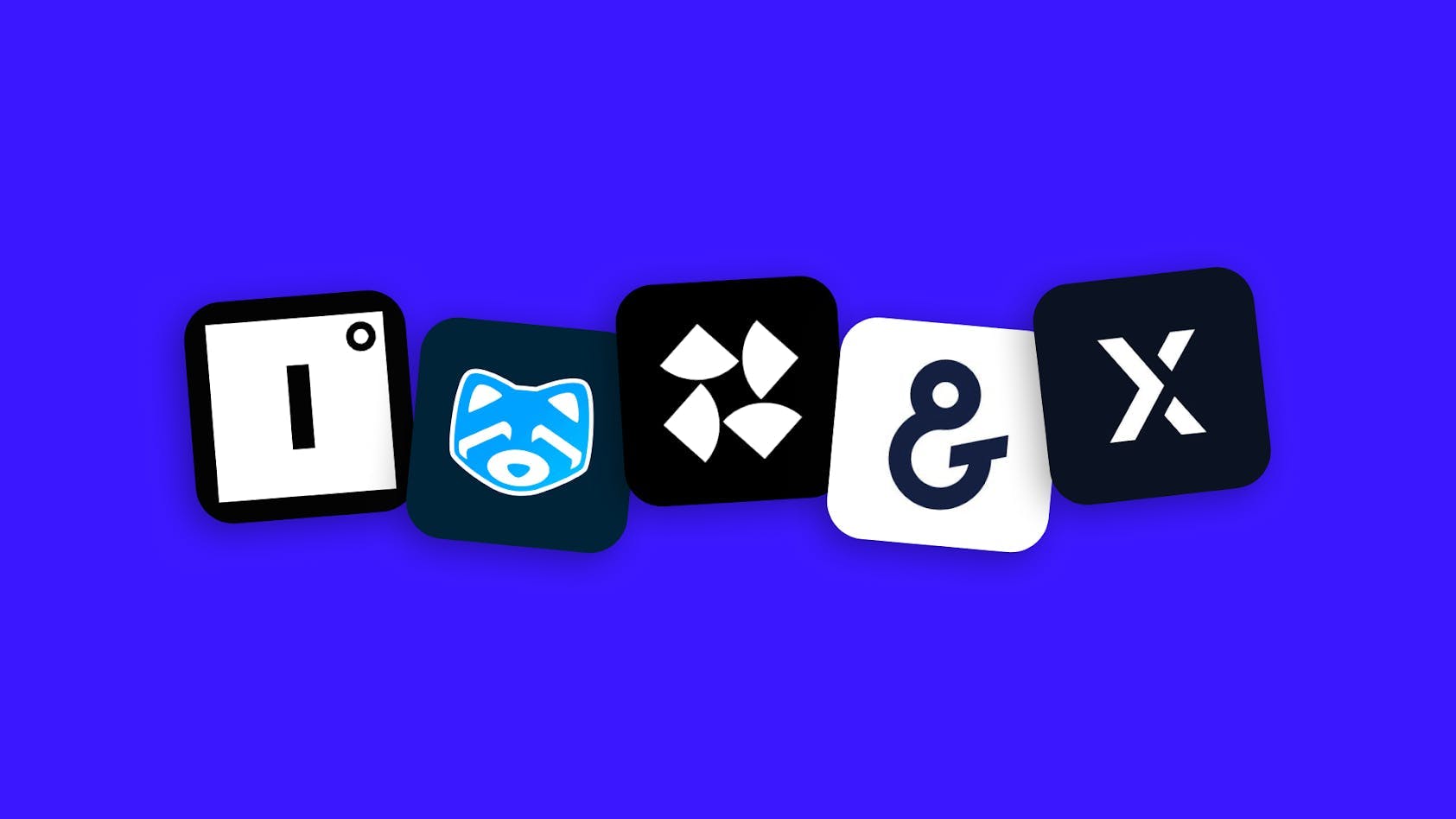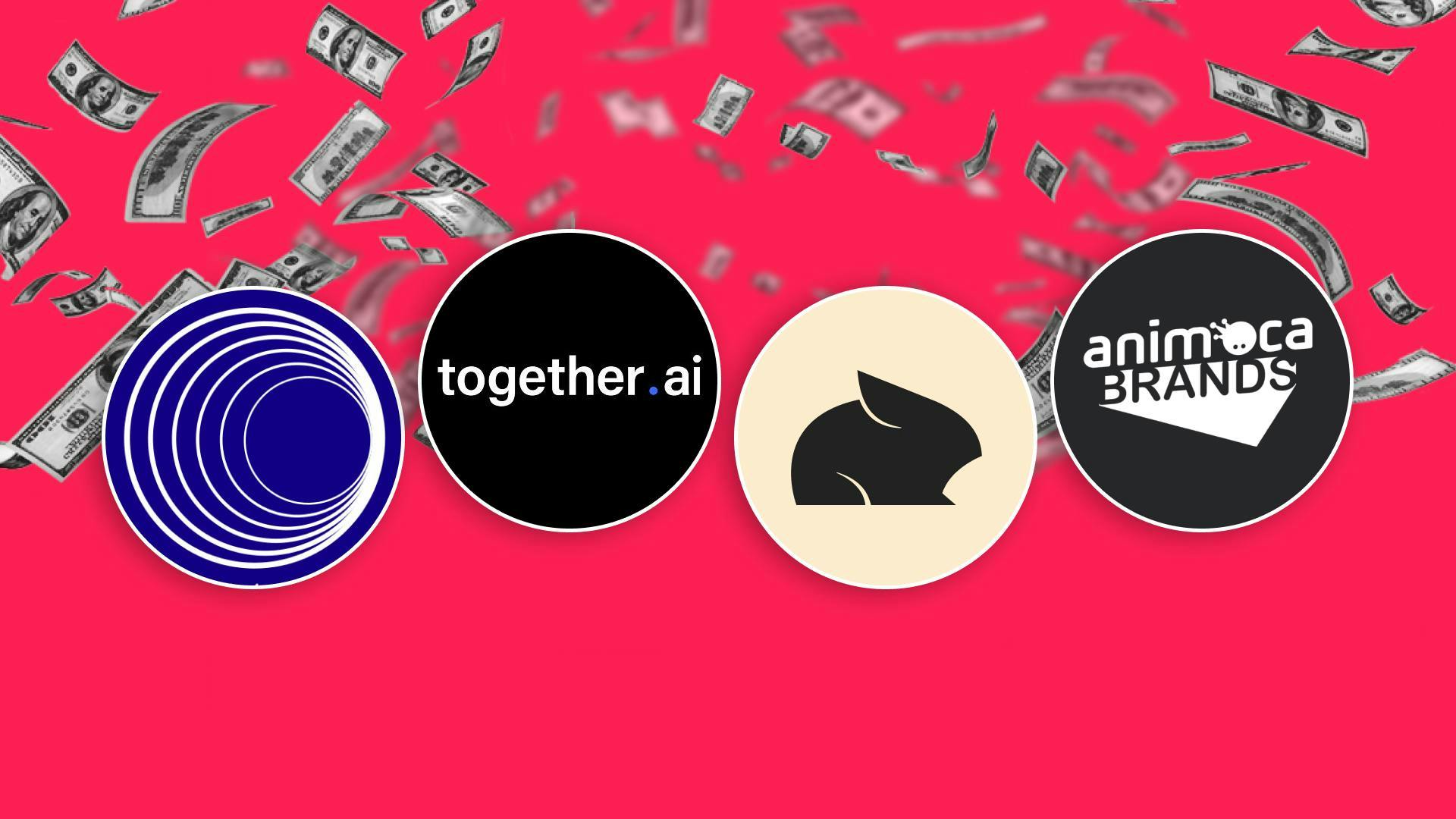The Blueprint to Innovate in web3 Design - A Comprehensive Guide to Building Robust Interfaces with AI
The success of web3 lies in the intuitive and consistent interfaces of its applications. This post aims to provide a detailed guide to designers navigating the complex world of web3 design, leveraging AI design tools like Midjourney and Dall-E, and ultimately innovating in the digital space. The encouragement here is to let your creativity run wild, and the intelligence at play is to let technology guide your journey.
Understanding web3: History and Essence
To comprehend web3, let's first delve into the evolution of the internet:
- Web 1.0, the pioneer of internet stages, was a decentralized realm, with content and platform ownership dispersed among various entities.
- Web 2.0, our current digital space, transformed under the influence of a handful of tech giants, notably Apple, Google, and Facebook (now Meta). As user participation surged, the internet grew increasingly centralized, controlled primarily by a small cadre of corporations.
- web3 represents a paradigm shift back to decentralized digital space, where the reigns of digital content and platforms are returned to the hands of the creators and users. Additionally, web3 addresses the pressing security and privacy concerns of the internet era.
- web4… is… well… TBD.
web3 encompasses four primary characteristics:
- Trustless: The control over the development, maintenance, and content of web3 platforms and DApps (decentralized applications) remains with the developers, content creators, and users. This is a stark contrast to Web 2.0, where control is relinquished to corporations and governments.
- Permissionless: web3 allows users to access any app without any company or government-issued authorization, relying on digital crypto wallets containing their private keys.
- Distributed: Power and control over digital products and services are equitably distributed among users, who earn ownership stakes based on their contribution to the development and maintenance of web3 platforms.
- Open: web3 operates on blockchain technology, an open ledger commonly used to record financial transactions, which stores data in individual blocks.
Designing for web3 is challenging and rewarding simultaneously, thanks to the decentralized nature of the space. web3 designers need to have a solid foundation in user experience design principles and an understanding of blockchain technology to create intuitive, engaging applications. However, with the right mindset and the correct tools, these challenges can be surmounted to create some truly innovative designs.

A Deeper Dive into web3 Use Cases and Challenges
Currently, web3 finds most of its applications in the finance sector, including cryptocurrencies, decentralized exchanges (DEXs) for trading, and nonfungible tokens (NFTs) that signify ownership of unique digital or physical items. Furthermore, decentralized finance, or DeFi, empowers users to bypass traditional banking systems and access peer-to-peer financial services.
However, the expansion of web3 to other sectors has proven to be a Herculean task. For instance, distinguishing a legitimate web3 site from a fraud poses a significant hurdle. The absence of an upload feature for images or videos on blockchain also hinders growth in areas like social media and gaming. In web3 video games, the inability to transfer assets represented by NFTs to other games or apps hampers player investments and discourages them from participating in web3 gaming.
web3 Design Essentials: How to Thrive as a web3 Designer
To thrive in the web3 space, designers need to understand and apply certain UI patterns and UX design principles. These can enhance the growth and user-friendliness of web3 platforms:
1. Master the Art of Clear Communication
First and foremost, designers need to be clear and concise communicators. Since web3 is a new and complex field, designers should not assume significant experience on the part of users. Instead, all unfamiliar features and actions should be adequately explained.
For instance, when users are depositing crypto funds into a liquidity pool, they should be notified about the potential value loss through a clear pop-up message. Similarly, when DeFi apps release security audits, designers should provide user-friendly summaries and notifications about these critical updates. Additionally, technical documentation should be supplemented with layman-friendly summaries, pop-up glossaries, and illustrative images to ensure a better understanding of complex web3 concepts.
2. Utilize Familiar Currencies for Better Understanding
To make things simpler for users, designers should display price conversions from crypto to users' native currencies in digital wallets and e-commerce apps where these tokens are transacted. This would make it easier for users to keep track of the value of their tokens and transactions.
3. Enhance Wallet and Transaction Hash Readability
Designers need to make blockchain addresses more readable. By default, a blockchain address is a lengthy string of characters known as a hash. A common error is sending assets to the wrong wallet address, which is irreversible and can result## Embarking on the web3 Design Voyage: Your Route to a Decentralized Future
As the digital world navigates towards a more decentralized internet landscape—Web3—it's paramount for designers to step up their game and breathe life into this burgeoning realm. Building user-friendly interfaces for web3 applications is the key to resolving the bewilderment and security concerns arising from this revolutionary shift.
Before we delve into the nuts and bolts of becoming a designer in web3, it's crucial to understand the web3 paradigm.

The web3 Revolution: A Snapshot
Imagine the internet where users have complete autonomy over the content they create, and monopolistic tech giants no longer control their online platforms. This is the promise of Web3—a decentralized model of the internet.
web3 empowers individuals with 'Trustless', 'Permissionless', 'Distributed', and 'Open' features. Users can build and manage web3 platforms and DApps—decentralized applications—without centralized authority, enter any web3 app with digital crypto wallets instead of company permissions, and contribute to a distributed ownership model of internet products and services. Moreover, it leverages blockchain technology for storing data in an open, chronological order.
Embrace AI Design Tools: Midjourney and Dall-E
As a designer, the cornerstone of your web3 voyage is integrating AI design tools into your workflow. Cutting-edge platforms such as Midjourney and Dall-E can streamline your design processes, providing insights and inspiration that were previously unattainable.
Midjourney, for instance, offers a plethora of tools to help you harness AI for smarter, more efficient design practices. It aids in curating personalized user experiences, boosting productivity, and generating content—redefining the traditional design approach.
On the other hand, Dall-E—an AI program that creates images from textual descriptions—can empower your designs with unparalleled creativity. With Dall-E, you can turn unique, complex design ideas into a reality without an extensive back-and-forth with a graphic designer. Imagine saying "a two-story pink house shaped like a shoe" and watching it materialize—this is the power Dall-E brings to your design toolbox.
The Memes Approach
A lighthearted, yet potent strategy to engage your web3 audience is through memes. Memes, the colloquial currency of the internet, are often overlooked in design strategies, but they offer a clever way to interact with users, creating a sense of familiarity and camaraderie. Harnessing the power of memes can help you resonate with your audience in a way that more traditional design elements can't always achieve.
Harnessing SEO: Engaging, Informative, and Catchy
To attract users to your web3 design, your content must be not only appealing but also SEO-optimized. Utilize keywords strategically to enhance your visibility in search engines. It's not about stuffing your content with keywords; it's about seamlessly integrating them into your message.
SEO also goes hand in hand with user experience. A well-structured, user-friendly design encourages visitors to spend more time on your platform, boosting your SEO performance. Remember to make your design engaging, informative, and catchy to ensure a better user experience and improved SEO rankings.
web3 Design Journey: The Challenges and Solutions
-
Making web3 Digestible: The concept of web3 can be overwhelming to many. As a designer, your goal is to translate these complex concepts into understandable, bite-sized information. Use pop-up glossaries, illustrative images, and user-friendly text to break down the jargon for your users.
-
Currency Conversion Hurdles: As the values of cryptocurrencies fluctuate, it can be challenging for users to keep track of their worth. Therefore, it's crucial to show price conversions from crypto to users' native currencies in digital wallets and e-commerce apps.
-
Managing Wallet and Transaction Hashes: Blockchain addresses or hashes can be quite long and error-prone when typing. Simplify this by showing only the first and last four characters for verification. Also, consider adding an extra layer of verification to prevent irreversible transactions to incorrect addresses.
-
Clarifying Transaction Times: Waiting for blockchain transactions can be nerve-wracking. Alleviate user anxiety by providing real-time transaction status updates or at least a link to an open-source block explorer.
-
Maximizing Ease of Transactions: Consider adding a “Send Max” button in your applications. This allows users to transfer their entire wallet balance with a single click—improving efficiency and accuracy.
-
Demystifying Gas Prices: Explain what gas is and how it works. Gas prices can be confusing, especially for crypto newcomers. Design solutions should aim to provide comprehensive information about gas prices and their impact on transaction speeds.
-
Simplifying Transaction Histories: Making transaction histories easily accessible and understandable can significantly enhance the user experience on web3 platforms.
-
Private Key Management: Users losing access to their digital wallets due to lost private keys is a major problem in web3. To solve this, consider providing a seed phrase—similar to MetaMask—that users can utilize# Untangling web3: A Comprehensive Guide to Embrace the Future of Design
In an era characterized by the rapid evolution of technology, the transition from Web2 to web3 promises to redefine our digital interaction and access. This shift towards a decentralized web platform opens doors to exciting new avenues. However, becoming a proficient web3 designer requires an acute understanding of the intricacies of this new digital ecosystem. This guide is tailored to provide you with the requisite knowledge, techniques, and tools, including AI design tools like Midjourney and Dall-E, to thrive as a web3 designer.
A. Gaining a Solid Understanding of web3
web3, often regarded as the future of the internet, signals a return to a decentralized web model. The concept pivots on eliminating the role of tech giants in controlling digital platforms and content. Instead, it promotes a decentralized model that fosters security, privacy, and user control.
Understanding the key aspects of web3 would help you navigate the shift smoothly:
-
Trustless: web3 ensures transparency in operation and code. Unlike the current internet landscape, web3 allows users to have independent verification about the development and management of applications.
-
Permissionless: The sign-in process to web3 apps doesn't require a corporate or governmental authorization. Users use their private keys through digital crypto wallets like MetaMask and TrustWallet for access.
-
Distributed: Unlike the centralized power in Web2, web3 distributes power and control over internet products and services among its users based on their contribution.
-
Open: web3 operates on blockchain technology, which records data in blocks. The transparent and chronological arrangement of these blocks ensures openness and accountability.
B. Comprehending the Challenges and Opportunities in web3
To effectively operate within web3, it is crucial to identify its challenges and opportunities. While web3 has seen significant strides in financial applications such as cryptocurrency, NFTs, and DeFi, its expansion into other sectors remains a work in progress.
Several roadblocks hinder the seamless adoption of web3:
-
Fraudulence: Discerning a legitimate web3 site from a fraudulent one poses a significant challenge, especially as users are required to input their crypto wallet credentials to access web3 platforms.
-
Media Limitations: Blockchain technology, as of now, doesn't support image or video uploading. This can limit its usage in various sectors, including gaming and social media.
-
Transferability Issues: The inability to transfer assets like avatars and purchased items between games and apps limits the potential of web3 applications.
Despite these challenges, opportunities for web3 are burgeoning, especially within the financial domain. NFTs, DeFi services, and cryptocurrencies offer an exciting array of possibilities for designers and developers alike.
C. Harnessing Design Principles for web3
To effectively navigate the web3 space, it is necessary to be equipped with the right set of design principles and practices:
-
Delivering Clear Prompts and Detailed Information: web3 apps are often complex and require users to have considerable experience. Designers must provide clear prompts and detailed instructions to navigate these apps. This could include pop-up warnings about potential risks or losses or summaries of complex sections of security audits.
-
Simplifying Cryptocurrency Exchange: Due to the constant fluctuation in cryptocurrency prices, it can be challenging to keep track of their value. Designers can incorporate real-time currency conversions into digital wallets and e-commerce apps to simplify this process.
-
Making Wallet and Transaction Hashes Readable: Blockchain addresses or hashes are long strings of characters that can easily lead to errors during transactions. Designers can simplify this process by showing only the first and last four characters of the hash, coupled with additional layers of verification.
-
Communicating Transaction Waiting Times: The processing time for blockchain transactions is typically not instantaneous, which can lead to panic among users. Designers can ease this stress by integrating a transaction status feature, text updates, or animations in the UI.
-
Implementing a “Send Max” Button: Typing the exact amount of cryptocurrency for transactions can be tricky due to the numerous decimal places. Designers can integrate a “Send Max” button to facilitate the transfer of the entire wallet balance with a single click.
-
Simplifying Gas Prices: Understanding the concept of "gas" in web3 can be confusing for newcomers. Designers can clarify what gas is and how it works, preferably in the user's native currency, to ensure ease of transactions.
-
Easy Access to Transaction History: Designers should aim to incorporate an easy-to-find and user-friendly transaction history within web3 apps to facilitate a comprehensive overview of a user's on-chain transactions.
-
Streamlining Key Management: The loss of private keys or seed phrases can lead to the permanent loss of access to one's digital wallet. Designers should aim to provide clear instructions on backing up these keys and constant reminders about their importance.
D. Embracing AI Design Tools
The growth of AI-driven design tools like Midjourney and Dall-E can revolution## Navigating the web3 Design Terrain: An Essential Guide
web3 signifies a major shift towards a more decentralized and equitable internet. This transition is as exciting as it is complex, particularly for those designing web3 applications. Understanding the unique features, challenges, and solutions of this space is key to navigating the web3 design terrain. This guide will help you leverage the power of AI design tools like Midjourney and Dall-E, understand the significance of memes, and tackle the intricacies of web3 SEO.
Understanding the web3 Landscape
web3, or the decentralized internet, is a paradigm shift from the current Web2 model. It promises a more equitable internet where control is distributed among users rather than centralized authorities. web3 is characterized by:
- Trustless: Users can verify information independently, without needing to trust a third-party authority.
- Permissionless: Instead of using company permissions to access applications, users leverage digital crypto wallets.
- Distributed: Control over internet products and services is shared among users, based on their contribution.
- Open: Blockchain technology is used to store data in an open, chronological manner, enhancing transparency.
Memes: The Underestimated Power of Humor
Memes have become an integral part of internet culture, and they can play a significant role in the web3 design world too. Leveraging memes in your design strategy can add a fun, familiar element, helping to connect with your audience in an engaging and relatable manner.
The Role of SEO
While SEO might not be the first thing that comes to mind when thinking about web3 design, it's a crucial component for attracting users to your application. Strategically utilizing keywords and creating engaging, user-friendly designs will enhance your visibility in search engines and contribute to a better user experience.
Navigating web3 Design Challenges
-
Making web3 Understandable: web3 can be a complex concept for many users. As a designer, it's crucial to break down this complexity into digestible, easy-to-understand information through user-friendly text, illustrative images, and pop-up glossaries.
-
Solving Currency Conversion Challenges: The fluctuating value of cryptocurrencies can make it hard for users to keep track of their worth. Displaying price conversions from crypto to users' native currencies in digital wallets and e-commerce apps is a practical solution to this problem.
-
Managing Wallet and Transaction Hashes: Blockchain addresses or hashes can be long and prone to typing errors. Simplify this by displaying only the first and last four characters for verification and adding an extra layer of verification to prevent irreversible transactions to incorrect addresses.
-
Clarifying Transaction Times: Waiting for blockchain transactions can cause anxiety for users. Help alleviate this by providing real-time transaction status updates or a link to an open-source block explorer.
-
Maximizing Ease of Transactions: Implement a “Send Max” button in your applications. This allows users to transfer their entire wallet balance with a single click, enhancing efficiency and accuracy.
-
Demystifying Gas Prices: Gas prices can be confusing, especially for crypto newcomers. As a designer, provide comprehensive information about gas prices and their impact on transaction speeds.
-
Simplifying Transaction Histories: Make transaction histories easily accessible and understandable to significantly enhance the user experience on web3 platforms.
-
Managing Private Keys: Users often lose access to their digital wallets due to lost private keys—a major problem in web3. To mitigate this, provide a seed phrase—like MetaMask—that users can use to recover their wallets.
web3 design presents an exciting challenge filled with unexplored possibilities. With this guide, you are well-equipped to embark on your journey into the decentralized future.







